Article updated on January 22, 2024
Text & photos: Claire Lessiau & Marcella van Alphen
Kaiseki-ryori is an art type, a true haute cuisine experience (comparable to Michelin-star restaurants) and the crème de la crème of Japanese gastronomy, serving and presentation. Kaiseki is a must for anyone visiting Japan and even only remotely interested in gastronomy!
If you like… upscale dining experiences,
…you will love kaiseki!
Pin this article for later!
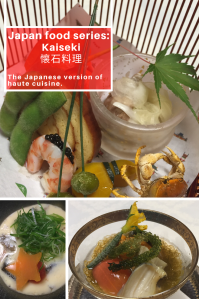
What is kaiseki-ryori?
Today’s kaiseki is inspired by several sorts of centennial Japanese cuisines, from the formal samurai type to the Buddhist one combined to the small dishes served during tea ceremonies. A kaiseki experience encompasses many small and varied courses in which different fresh, local and seasonal ingredients are all cooked in different ways and presented differently. Repetition is not an option! The chef has to master a wide array of cooking and sophisticated arrangement techniques.
Obviously, the tableware and setting have to match the quality of the gourmet feast. Often set up around a zen garden, in a peaceful and refined environment kaiseki meals are typically served in private rooms with a designated waitress.
If kaiseki style meals are generally offered in ryokan (traditional Japanese inns) or even as bento boxes in a more casual way, Kyoto that had hosted the imperial court and nobility for over a millennium is the place to experience it!
There is no set menu for a kaiseki, but specific types of dishes are traditionally served and presented according to the cooking method (boiled dish, grilled dish…). The names of these dishes are highlighted in the next section.
A kaiseki experience in Kyoto, the kaiseki capital!
Two white curtains hang by the entrance of Harise restaurant in an alleyway in the Gion district. Our hostess for the evening is expecting us and welcomes us in a beautiful light blue kimono. We take off our shoes and follow her along a hallway bordered by a lovely zen garden in the heart of Kyoto into our private tatami room with traditional sliding doors. A low table set for two with chopsticks resting on a beautiful piece of Kyoto ceramics awaits us. Our hostess lets us sit comfortably on the low chairs, and hands us the set menus politely. In this traditional kaiseki restaurant favoured by Japanese gastronomes, the menus were translated specifically for us. The waitress comes back, sits on her knees, bends and tells us… in French… that she will start serving us! This sets the tone: every detail is carefully sought-after all the way to assigning a French-speaking waitress to a French guest to provide an unforgettable and most refined experience for us to purely enjoy these eleven dishes that are about to be presented to us.



First, we are served a cold green tea and order two different sake, the traditional drinks to accompany a kaiseki. Both are presented differently: one in a thin glass tea pot, the other, slightly sweeter, in a hand painted glass jar.
The sakizuke (先附 or amuse-bouche) is simply mind blowing! A sugar tomato and a piece of soft grilled eggplant is topped off with sea urchin in a juice of thin Mozuku sea-weed (a crunchy local vegetable) and decorated with a yellow flower served with a delicious sweet prune wine.

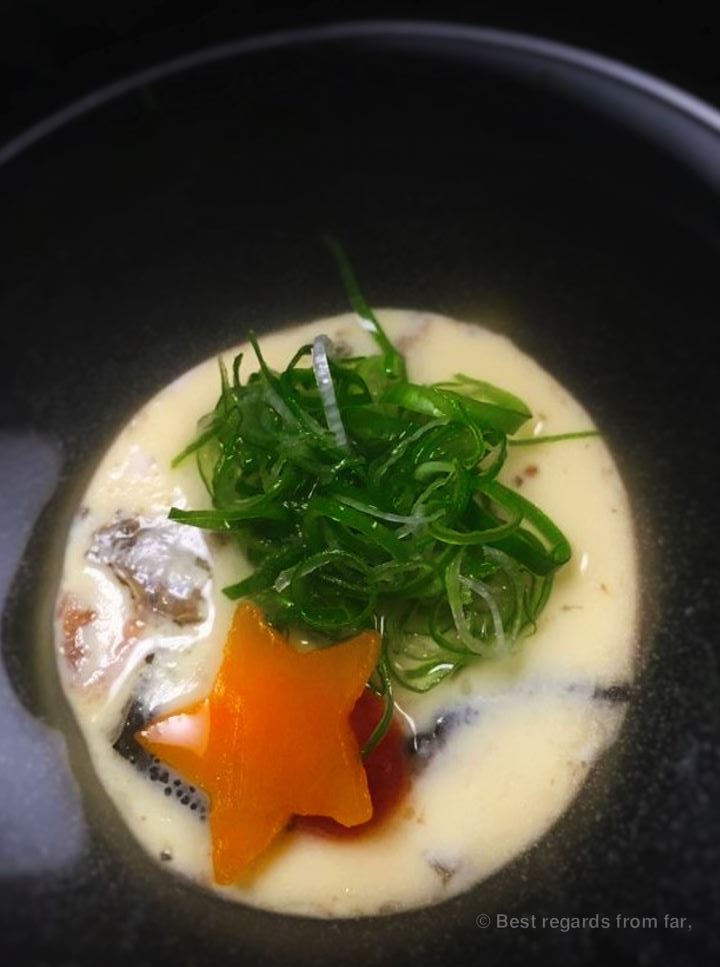
The second dish is the takiawase (煮合). It consists of the Emperor’s meal: a piece of simmered soft-shell turtle* served in a savoury steamed egg custard floating in a clear broth.
A beautiful Japanese ceramic tableware follows. Mukōzuke (向付) is presented on a thin wooden mat supported by small ice-cubes: sashimi of raw sea-eel, cuttlefish, yellowtail amberjack and maguro tuna spiced up by homemade wasabi and soy sauce, and topped off with a tasty purple flower for the finishing touch. These slices are cut only in the finest part of the fish and do set themselves apart from already delicious regular sushi.


Our next course is called hassun (八寸) and comes in a delicate basket filled with delicious fried ginkgo nuts, sea urchin, pumpkin, octopus, soy beans, prawns and a fried freshwater crab seasoned with jellyfish vinegar. Our hostess tells us to eat the crab as a whole, including the scissors, legs, head, etc. A bit cautious at first, the crunchy crab is actually mouth-watering as is the rest of the hassun dish that typically introduces the seasonal theme of the meal.
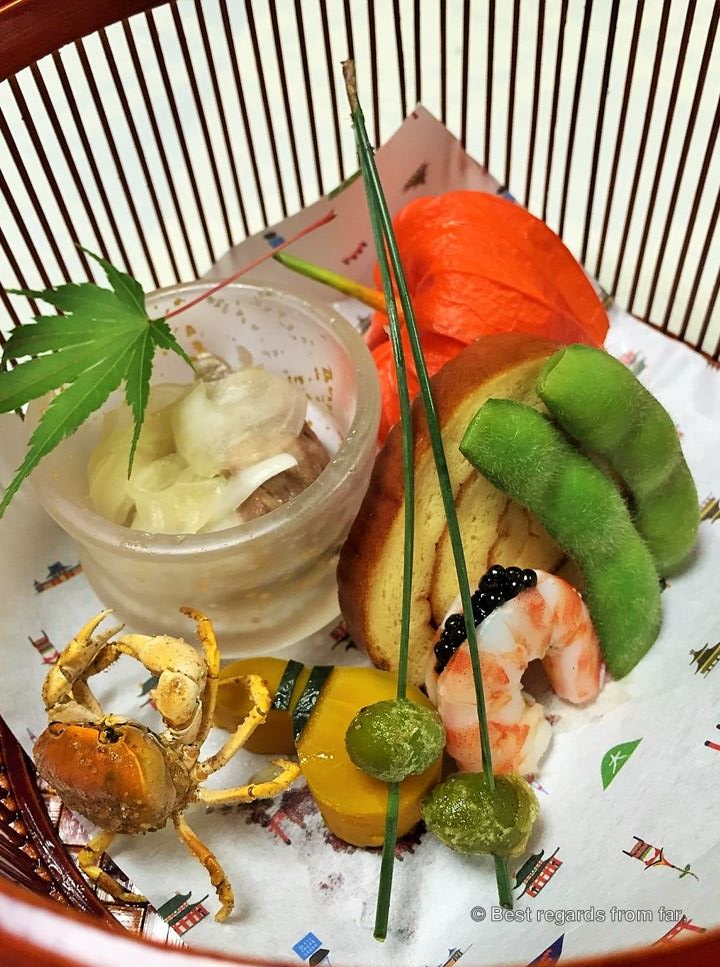

The grilled dish, or yakimono (焼物) is also to be eaten as a whole, head to tail: grilled sweet fish with a salty green sauce, accompanied by a young peach on a white wine jelly. The exquisite tastes, structures and flavours are a real discovery for us!
A sea-eel in peppercorn, a Kamiel-nasu eggplant and melon precedes the shiizakana (強肴 or substantial dish): a perfectly cooked piece of beef with black vinegar and sour cream, just melting on our tongues.


According to the tradition, gohan (御飯) is the rice course, served by the end of the kaiseki with a red miso soup, pickles and a freshly brewed brown tea.
The seasonal dessert – mizumono (水物) – consists of cubes of watermelon and Yubari melon with a sesame tiramisu seasoned in Muscat.
This wonderful experience is concluded by a tea ceremony: our hostess serves us the delicious matcha tea according to the tradition, along with wagashi (菓子) or traditional Japanese confections made of red bean paste and decorated with silver foil.


With this kaiseki dinner, we have experienced how Japanese chefs respectfully turn a wide variety of high-quality ingredients into true art: wonderful to look at, a shame to start touching, and causing a truly magnificent explosion of textures, appearances, colours and flavours!

Kaiseki etiquette
Knowing all the complex etiquette is not our topic here, but instead to give you a few pointers for common situations. The bottom line is that a kaiseki meal is highly sophisticated and refined, and every one of the staff does one’s utmost to transcend your experience: show respect and appreciation. With this in mind, you can hardly go wrong. This being said, here are a few basics:
- Know your chopstick 101: do not use them as knifes or forks, do not stick them in dishes (especially not in a rice bowl), and put them back on the chopstick rest when not in use.
- When the hassun dish is brought, chopsticks with ends on both sides can be given to you. This is in order to not have the fish taste impact the flavours of the vegetables. Use one end for the fish, the other for the vegetables and make sure to hold the chopsticks in the middle.
- As the food is brought to you with great care, use great care as well to enjoy it and show your appreciation.
- Lift tableware closer to your mouth only if the dish is difficult to eat. For ingredients that are tough to eat in one bite, it is OK to bite off pieces. Finish it entirely: do not return the food to the tableware. For skewers, if the food is difficult to slid off with your chopsticks, have it directly from the pick in the privacy of your napkin.
- Eat the food as soon as it is served to you: the chef ensures it is brought at the optimal temperature to be the most flavourful.
Where to enjoy kaiseki in Japan: there is something truly special about enjoying it in a traditional wooden house in the Gion district in Kyoto! Try Harise!
* bred soft-shell turtles
Travel tips:
- Check out this interactive map for the specific details to help you plan your trip and more articles (zoom out) about the area!
For everything about Japan, click here!
For more delicious Japanese food, click on the images below:






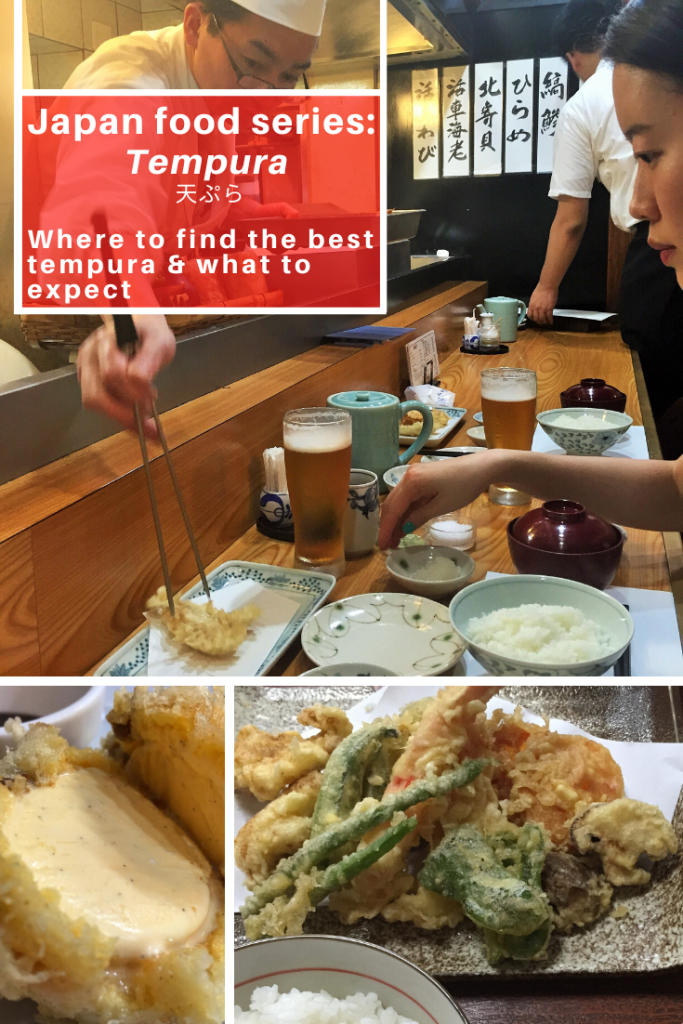
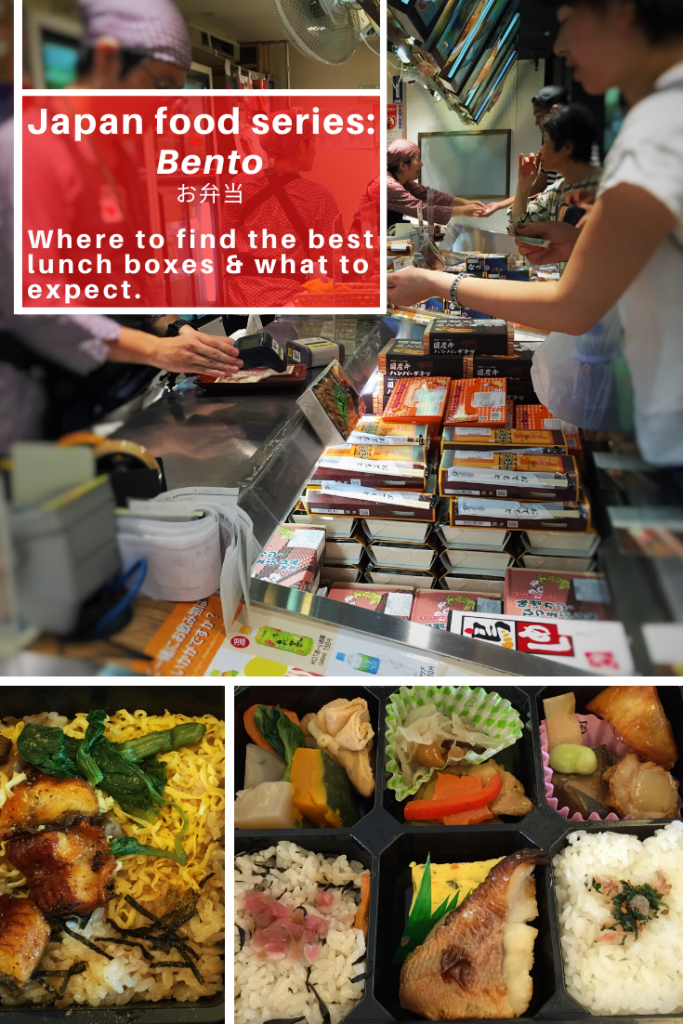
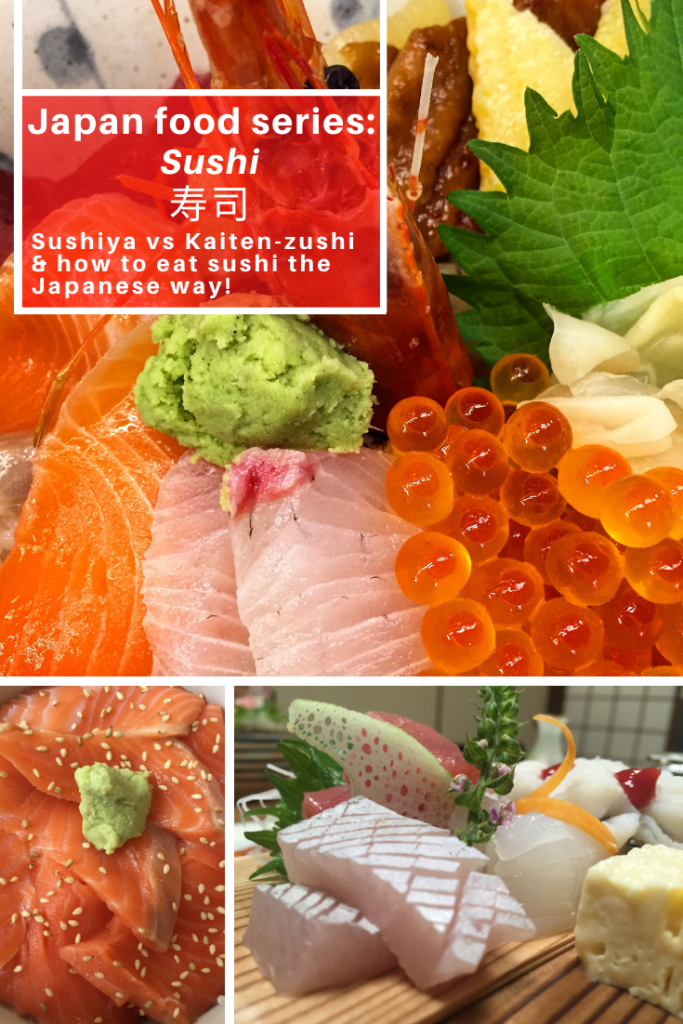
Stunning!!